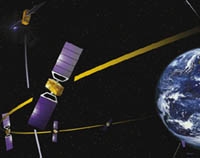August 6, 2003
How orbital manoeuvres work
To accomplish its mission, a satellite or spacecraft must keep to a very specific trajectory.
First, it has to reach that trajectory and stay there. It also has to remain pointed in a certain direction with respect to the Earth and Sun. It is this attitude that ensures it gets sufficient solar energy, can acquire images in the right illumination conditions and can communicate with Earth.

But while theory dictates that a satellite should sustain a perpetual and undisturbed trajectory, the reality is altogether different. Once on station, a satellite does not stay there indefinitely without outside help. The reason is that it is subjected to disturbing forces that gradually brake or accelerate its motion on each orbital revolution.
Space exploration therefore involves much more than just designing and launching spacecraft.
We also have to work with the laws imposed by space, and find solutions to control our space assets remotely and keep them on the right track.
In short, we have to learn how to “drive” our spacecraft before climbing aboard…
We also have to work with the laws imposed by space, and find solutions to control our space assets remotely and keep them on the right track.
In short, we have to learn how to “drive” our spacecraft before climbing aboard…
Last updated: April 2004